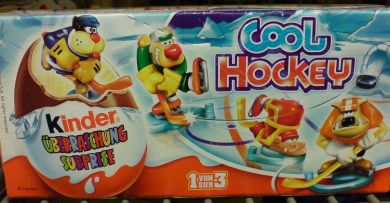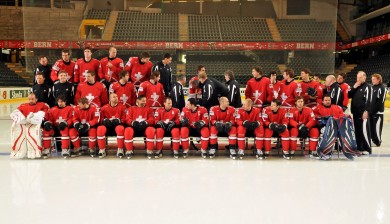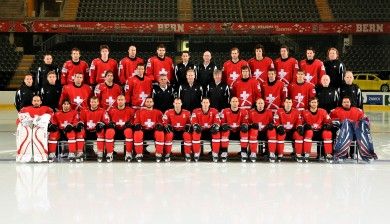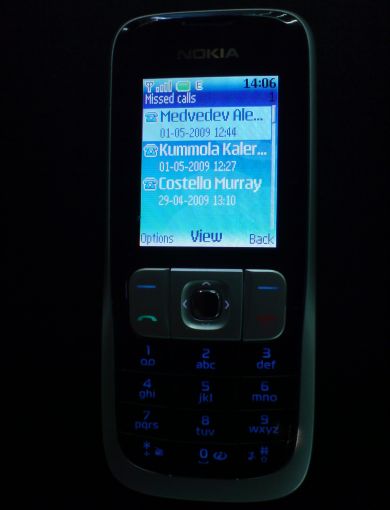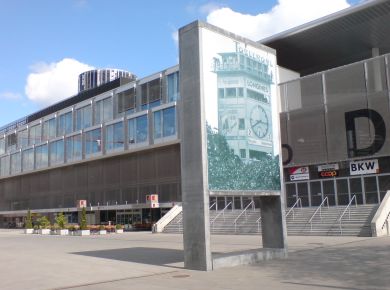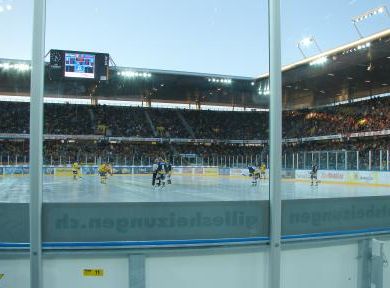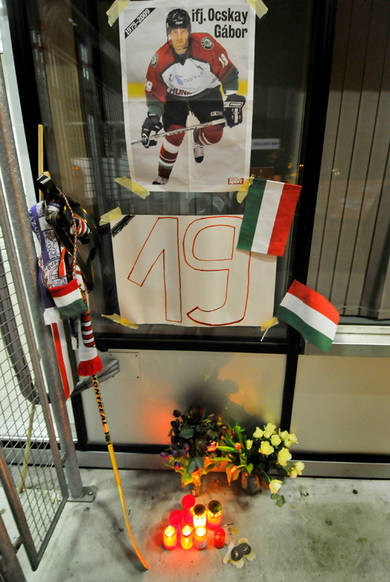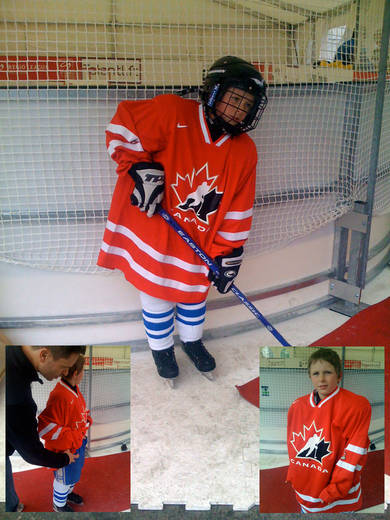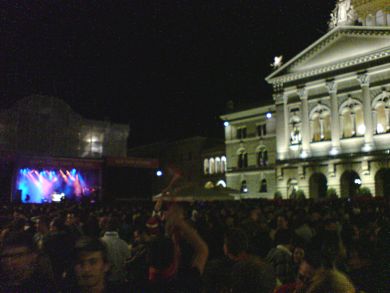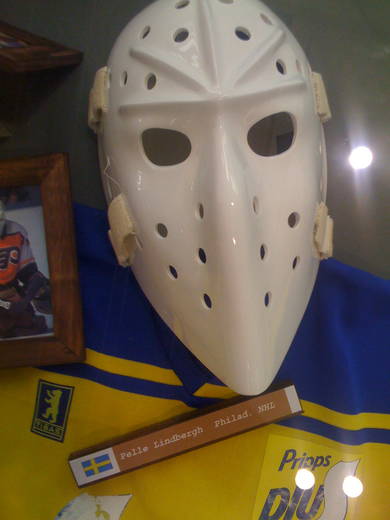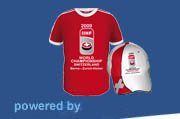Welcome to the IIHF Worlds 2009 blog. Throughout the championship you will be able to read about our impressions behind the ice in Berne and Zurich-Kloten.
May 7 / Lucas Aykroyd
There are certain things that are never to be shown on the big video screen at an IIHF World Championship game. Most of them are pretty easy to guess, such as anything that would garner a movie an R- or X-rating.
However, another one should be added to the list: sleeping fans.
It definitely wasn't a good omen for Team Finland when the camera caught blue-and-white supporters catching 20 winks on more than one occasion during Wednesday's 3-2 quarterfinal loss to the United States.
Switzerland, of course, is a democratic country, and ticket-buyers have the right to do as they please, as long as they don't snore so loudly that they cause discomfort to surrounding fans.
But it just didn't send the right message.
When Finnish coach Jukka Jalonen called a timeout in the second period, his club trailing 3-1, perhaps he should have poured a bucket of cold water over his players' heads and then marched into the stands and done the same to the sleepers. Because judging by the lack of a late rally, none of the Finns in the house woke up in time.
May 4 / Martin Merk
Who doesn’t know them? Those chocolate eggs called Kinder Surprise. Milk chocolate with a creamy milk lining and inside a surprise, usually figures or toys to be built together. In Switzerland, the official partner of the 2009 IIHF World Championship brought its newest edition “Cool Hockey” to the supermarkets. So that also kids can “play hockey” while the junior season is over in Europe. And as children start to discover the internet early nowadays, they can also help the animals in hockey equipment in a hockey game on the Kinder website. Or check out a second online game with Kinder’s hockey animals.
May 3 / Lucas Aykroyd
Covering an entire IIHF World Championship enables you to get intimately familiar with the host arena's music playlist. As a rule, it doesn't vary much from night to night. Oh sure, the game presentation folks might throw in ABBA's “Mamma Mia” when Sweden is playing, or cater to Russian fans with “Kalinka.” But otherwise, they've got a game plan, and they're sticking to it.
For Berne's PostFinance Arena, the game plan focuses on the finest musical decade in the history of humanity: the 1980s. (Or at least the funnest.)
I realize I may just have alienated a sizable percentage of the IIHF.com audience, but bear with me on this. I didn't say it was an unmixed blessing.
Now, in a hockey arena, you won't hear many 1990s grunge bands like Nirvana or Pearl Jam because their reclusive, downbeat grunge attitude doesn't fit with hockey's up-tempo, forward-thinking vibe. Tunes of the 60s and 70s bring the sing-along factor, but mostly not the kind of massive, polished production that sounds so good in a big, echoing venue (with exceptions like Queen duly noted). Hence, it's got to be the 1980s.
However, my only personal quibble with the PostFinance music maestros is that instead of leaning on such adrenalized, might-as-well-jump 80s hard rockers as Def Leppard and Van Halen, they treat us to multiple renditions of “Funkytown” (1980) by Lipps Inc. and “Kiss” (1986) by Prince at each game. “Hey Baby” by DJ Ötzi, a reworking of the #1 Bruce Channel hit from 1962, is also heard frequently. I guess I just wanna rawk.
More so than at North American arenas, the fans here are often happy to supply their own sing-along material without prompting from either the PA or scoreboard. And when they're happy, we're all happy.
May 3 / Risto Pakarinen
BERNE – The World Championship is truly where the hockey world gets together. That’s easy to see just by walking around the arenas and admiring all the fans with their face paintings, flags, and jerseys from all over the world.
But today it occurred to me what a truly international game this is.
I was in the mixed zone after the Austria - Germany game, and within ten minutes, I heard Austrian forward Oliver Setzinger speak Finnish, Germany's Canadian-born forward Travis Mulock English, listened to Austria’s Swedish head coach Lars Bergström give his post-game statement in German, then being interviewed in Swedish.
Denmark’s Swedish head coach Per Bäckman does his press conferences in German, and Russia’s Slava Bykov in Russian and French. Germany’s media officer Tommi Melkko speaks perfect Finnish. Switzerland’s Canadian-born head coach Ralph Krueger does his press meets in German and English, and France’s Montreal-born David Henderson in English and French.
And they all like to talk hockey.
May 2 / Matthew Manor
The official IIHF photography crew, typically comprised of the finest (we like to think) Finnish and Canadian hockey photographers in the world, handles a ton of assignments at the World Championship each year. One involves organizing and taking the official team photo for all 16 participating teams.
This, of course, has to be worked into each team's busy schedules, among other arguably more important tasks, such as practising, playing and resting. To further complicate matters, many of the teams add NHL players throughout the tournament as they become available from their various clubs. Understandably, teams often prefer to wait until their rosters are complete before committing to a time and date for their team photo.
With all that said, the IIHF photographers are experienced with this sort of thing, and have refined the process so that they can finish a typical team photo session at the rink in about 10 minutes.
This includes setting up the chairs, benches and whatever else is needed for the placement of the players and team personnel; checking and re-checking the details of each person in the photograph to ensure everything is just so; taking about 20 to 30 shots to ensure everyone has their eyes open in at least one of the images; and finally, getting the chairs, benches and staff off the ice so practice can begin.
It might sound straightforward, but there are things that the teams can do to influence the process, which can either speed things up or slow them down. Nobody knows this better than the management and coaching staff of Team Switzerland.
Last year in Quebec City, the Swiss team set an unofficial record for the fastest team photo session of the tournament, completing their session in less than four minutes. Head coach Ralph Krueger wanted to complete the session quickly to ensure the team could get as much practice time as possible. And they pulled it off thanks to team leader Marcel Enkerli's excellent pre-planning of player and staff placement within the photo.
In 2009, for the second time, the Swiss have conducted one of the most efficient team photo sessions of the tournament. What is their secret?
Marcel meticulously draws out a poster-sized seat map of where each player and staff member is to be positioned in the photo, and then briefs the team. He gets them reasonably well-organized on the bench, where they wait until the ice resurfacing is finished. As soon as the first row of chairs is set up, he begins calling on the players and staff required to fill those spots. Next, he does the second row with standing individuals, and then the third, all in correct order. All within a couple of minutes. Then, snap snap snap! Photos finished, history recorded. The players help clear the chairs and benches off the ice, and they're ready for practice.
Another thing that makes this procedure is that apparently, the Swiss team organizes their rows based on the seniority of the players and personnel. Those who have the most seniority sit in the first row, while newer ones end up in the third row.
May 1 / Lucas Aykroyd
Members of the IIHF Council, IIHF staff, and organizing committee, as well as other associated individuals, are issued special mobile phones for the duration of the IIHF World Championship.
So what?
Each phone comes preloaded with a list of contacts. And since whoever set the phones up this year misspelled my name as “Akroyd Lukas” (word to the wise: the correct spelling appears above), I'm at the top of the list alphabetically.
This apparently means everybody wants to talk to me. EVERYBODY.
For instance, today, I had missed calls from IIHF Vice-President Kalervo Kummola (President of the Finnish Ice Hockey Association) and IIHF Council Member Alexander Medvedev (KHL Head and Deputy Chairman of Gazprom).
The Kummola missed call completed my hat trick of IIHF Vice-Presidents, as IIHF Vice-President Murray Costello (ex-NHLer, Hockey Hall of Fame member and Chairman of the IIHF Medical and Junior Committees) and IIHF Vice-President Shoichi Tomita (Japanese Olympic Committee member and Chairman of the IIHF Asian Oceanic and Development Committees) also attempted to get hold of me on April 29 and April 27 respectively.
However, I'm very busy writing articles for IIHF.com, so I'm not doing interviews right now. I trust none of the aforementioned dignitaries will take offence.
May 1 / Risto Pakarinen
BERNE – The mixed zone can be a jungle, with all the reporters trying to get to the players, hear their comments, and record their insights, and they (yes, we) all want to do it right now.
In Berne, one of the teams always stays in the mixed zone for interviews right after the game, as the players get off the ice, while the other goes to the locker room, and players that the reporters have requested then return to the mixed zone for interviews.
It can be difficult to recognize some of the players without the equipment. Especially players from the country the reporter is not from.
Obviously, the Swiss reporters recognize the Swiss players, and the Russians their own, but when they step to the other side, and approach players on the other team, they rely on obvious clues such as the players’ numbers and nameplates on their jerseys.
The Swedes have been mixing it up a bit by returning to the mixed zone wearing each others’ jerseys. Niklas Persson may have worn Stralman’s jersey and the number 28 you have seen talking in front of the mikes may not have been Dick Tärnström, but Loui Eriksson.
That’s sneaky.
As a colleague of mine said here: "The only Swedish players that should be able to get away with switching jerseys are the Sedins."
April 30 / Martin Merk
BERNE – The Wankdorf district in Berne is worshipped by German sport fans. It’s there, where a piece of sport history was written, especially in the eyes of Germany, the winner of the 1954 FIFA World Cup.
Germany was out of competition for many years following World War II. In hockey, they came back in 1953 and won silver, also in Switzerland. But the tournament in Zurich and Basle saw only three teams playing. The North Americans didn’t come, and the Czechoslovaks went home when the country’s president passed away.
The German football comeback one year later was more exciting. The Germans were rookies and had never won a medal before. Hungary was the big favourite. The Mighty Magyars were nursing an unbeaten streak of 33 games that had lasted more than four years. They also hammered Germany 8-3 in the preliminary round. But not in the final. After an early 2-0 lead, the Germans turned the game around to win 3-2 in the old Wankdorf Stadium in front of over 60,000 spectators, with millions of Germans listening to the radio broadcast.
The unexpected victory was named Wunder von Bern (Miracle of Berne) and was immortalized in many books. Movies about it have also been made; the last one arrived in the cinemas in 2003. In Germany, the miracle is still regarded as a symbolic turning point and euphoric moment for a country humiliated by war.
The news that the outdated stadium would be demolished in 2001 to build a new stadium (which also hosted three Euro 2008 matches and brought an orange invasion of about 100,000 Dutch fans to the city) lured many Germans to the place of worship for a good-bye. The famous match clock stands in front of the new stadium and its shopping mall like a memorial.
The new Stade de Suisse also hosted an outdoor hockey game in front of 30,076 fans, a record in European club hockey. Just 300 metres away is the PostFinance Arena.
Fifty-five years after Germany's Wankdorf triumph in football, the German hockey national team came to Berne seemingly without pressure, as they can’t be relegated as the host team for the 2010 IIHF World Championship. But of course, they wanted to present themselves in a good light while getting ready for the 2010 Olympics and next year's Worlds.
Instead, they lost 2-1 to France in the critical game that sent them to the Relegation Round. That regrettably led some German fans to throw beer at national team coach and legendary player Uwe Krupp.
Since the expansion of the World Championship to 16 teams, Germany didn’t make it to the qualification round only in Switzerland 1998 and Austria 2005, and wound up getting relegated both times. This won’t happen this tame.
As a sort of consolation, fans will see Germany versus Hungary in Wankdorf – just in hockey – at PostFinance Arena, on the last day of the Relegation Round. But the Germans can only avoid a Mishap of Berne. Or, alternatively, allow Hungary their hockey miracle.
April 30 / Lucas Aykroyd
The things you hear and see at the World Championship invariably remind you of how small and close-knit the hockey world really is. Ralph Krueger, head coach of Team Switzerland, and Anders Hedberg, head pro European scout for the New York Rangers, had a laugh yesterday while getting lunch at the tournament VIP room. Krueger, a Canadian-born native of Winnipeg, remembered standing in line at his old high school to get his hockey stick autographed by Hedberg, who starred for the WHA's Winnipeg Jets in the 1970's, playing on the top line with fellow Swede Ulf Nilsson and the legendary Bobby Hull. “I still have that stick in my basement,” Krueger said. Hedberg interjected with a hearty laugh: “That's because he's tried to sell it and nobody will buy it from him!”
Apr. 29 / Andrew Podnieks
Although the World Championship is a wonderful thing, for the two North American writers in Kloten the pleasure of following the NHL playoffs in tandem presents a logistics nightmare. John Sanful (New York) and yours truly (Toronto) haven’t had the time or the energy to stay up most of the night to watch any Cup games back home, but last night’s Washington-Rangers game promised something special, so we made the extra effort after watching Canada hammer Slovakia at the local arena. However, Kloten is a small town with few suitable places for watching overseas hockey, and we couldn’t find anywhere in downtown Zurich that (a) stayed open until at least 4am and (b) had a satellite TV to show us the game. As a result, we were forced to buy an internet package and watch huddled over John’s laptop in our hotel lobby. But the hotel signal isn’t very strong, so the boys had to watch a jumpy, sometimes frozen series of pictures. Extreme fatigue caught up with us after two periods, so we were forced to go to our various rooms to sleep before security cuffed us and hauled us away. The problem gets worse starting today because Washington (Ovechkin) now plays Pittsburgh (Crosby) in the next round of the playoffs. Thought of missing the series because of lack of sleep is totally out of the question, but the prospects of staying up all night seven times is fatiguing just to think about.
April 29 - John Sanful
On the left side of the ticket window at the Kloten arena, near the entrance, there is a shrine that has been created by Hungarian supporters to honor the memory of deceased national team forward Gabor Ocskay. Fans have placed a picture of Ocskay, a hockey stick, medal, lanyards, flowers and candles all in tribute of their fallen hero.
Ocskay was a member of the national team going back to 1993 and a longtime member of club team Alba Volan Szekesfehervar. Ocskay, 33, played 187 times for Hungary's national team and was instrumental in helping them move from the C Pool to their return to the top tier of the world championships for the first time in 70 years. In March, Ocskay suffered a heart attack. He was expected to represent Hungary here at the 2009 World Championships.
April 29 / Lucas Aykroyd
Without the 1,000 volunteers in Berne and Zurich-Kloten, the 2009 IIHF World Championship simply wouldn't be possible. Whether it's security, media relations, transportation, team hosting, or other areas, their contributions will keep the tournament running smoothly right through the gold medal game on May 10.
But frankly, it's a lot more fun to see the volunteers in action than to read whatever praise I may heap upon them. Head to this gallery to check out hundreds of candid shots taken by and of volunteers in recent days.
April 28 / Andrew Podnieks
The arena in Kloten is a terrific old barn but it was never built with eight teams in mind. As a result, there are some interesting and creative solutions to providing dressing rooms for all the countries playing here. Being top ranked, Canada got first dibs on rooms, and it chose the main room which is near the ice surface. Other teams are not so fortunate. Some rooms are located down a long hallway that runs the length of the ice, under the seats. Other rooms are a long walk plus a flight of stairs. And then there is Denmark. The Danes have to actually leave the arena to get to their room, and on the first couple of days fans entering the building for a game could see the players in and around their cubicle cutting and taping sticks, stretching, and the like. Yesterday, maintenance crews built an extra wall around the area for some sense of privacy and security, but the truth is that almost all of the teams have a walk of nearly 100 metres to get to the ice from their dressing rooms. As a result, the IIHF has extended the length of intermissions for games here from 15 to 16 minutes, to take into account the lengthy walk.
April 28 - John Sanful
Let’s talk scoring: We’ve seen a lot of it in Kloten. Eight of the top ten scorers so far in the tournament are playing in Kloten. Martin St. Louis, Petr Cajanek, and Jason Spezza are tied for second in scoring with five points. Over the first four games of the tournament, there have been 49 total goals scored. The winning teams have scored 41 goals while the losing teams have scored 8. Canada has the single game high here with their 9-0 drubbing of Hungary. On Saturday winning teams- Finland and the Czech Republic- pitched 5-0 shutouts.
April 27 John Sanful
ZURICH-KLOTEN - You have to admire the enthusiasm of Hungarian hockey fans. For years we’ve been talking and writing about Latvian fans, but Hungary fans here can give them a run for their money.
Hungary has yet to win a game and the odds against them being able to avoid relegation but you’d never know it from fan reaction.
Take as an example yesterday’s game against Canada. Despite being routed 9-0, fans were on their feet and cheering for nearly sixty minutes. After the game, Levente Szuper acknowledged the support of fans.
“Just listen to them,” said Szuper after the game. “These fans are great. They come out and support our efforts win or lose.”
Conducting interviews in the mixed zone was sometimes challenging as Hungarian fans lingered in the arena some thirty minutes after the game was over- still chanting, still clapping, and soaking in the afterglow of watching their side compete in top division World Championship.
In a nice gesture, the entire Hungarian team returned to the ice to wave at their fans that began singing the national anthem. In an age where most of us are cynical and expectations run high for athletic success, it’s refreshing to see these simple things as they demonstrate why hockey is beloved by so many in countries still developing their programs.
By the way, look for an article coming soon on Szuper on iihf.com
April 27/Andrew Podnieks
Kloten’s arena is perhaps the only major hockey facility located in the depths of a forest. Fans who get off at the city’s main train station must walk into the middle of the woods to get to the arena, and once there they can see only trees and beautiful nature all ‘round. There are trails inside for joggers, principally a 9km route and a 5km version, and every day members of the teams take advantage of their surroundings to go for a training or maintenance run. Paradoxically, Kloten is right beside the airport, one of the busiest in Europe, so while people walk through the woods they can look up and see a jumbo jet preparing to land or just after takeoff.
April 27 / Risto Pakarinen
BERNE – Everybody remembers the way Wayne Gretzky always tucked his sweater into the pants, always on the right side. Originally he started to do that as a little boy, because playing with kids many years older than him, the team's sweaters were just too big for him and got in the way of his stickhandling. So, Wayne's father, Walter, came to rescue and tucked the sweater into the pants.
Patrik Messerli, one of the little guys that participated in an exhibition tournament outside the PostFinance Arena, may be a new Gretzky, you never know.
Sure, Gretzky didn’t start his career skating around pylons on a plastic “ice” like Patrik - the famous “Wally Coliseum” had the natural kind - but times have changed.
However, Patrik’s got off to a good start. You can’t see it on the official Patrik Messerli publicity shot but yes, his father did tuck the sweater into the pants, Gretzky-style.
April 26 / Martin Merk
BERNE - Berne is just the fourth-biggest city in Switzerland, but it’s in an ideal geographic location to be the capital and home of the Federal Palace. It was here that the 2009 IIHF World Championship kicked off, parallel to the on-ice and off-ice action at PostFinance Arena.
One of the highlights was the concerts on Saturday. National artists like Bligg and Francine Jordi entertained the crowd of about 3,000 people in the afternoon and evening on the square in front of the building where politicians usually go in and out. A DJ entered the stage at midnight to conclude the event and to bring hockey fans as well as Berne’s night owls to the outdoor event. Jerseys were ubiquitous, as were the famous Skoda paper helmets. An abundance of beer, sausages and chicken wings made everyone feel almost as if they were in the arena.
The festivities continue with more concerts Sunday afternoon prior to the showing of the Switzerland-Germany game on a big screen.
April 26 / Lucas Aykroyd
BERNE - The 2000s were a great decade for the IIHF World Championship, and you can relive those glorious moments by calling the number on your TV screen and ordering the Ultimate IIHF 2000s compilation right now! Don't delay! Operators are standing by! (Just kidding.)
But since the nostalgia cycle will officially kick in as of next year, let's beat the rush with a brief retrospective on highlights and lowlights of the 2000s at this tournament.
Best Gold Medal Game
No question about this one. Ilya Kovalchuk scores in overtime as Russia earns a 5-4 comeback victory over Canada in the 2008 final in Quebec City in the IIHF's centennial year. Honourable mentions to a pair of 3-2 OT wins: Canada's over Sweden (2003) on Anson Carter's video-reviewed wraparound goal and the Czech Republic over Finland (2001), courtesy of David Moravec.
Worst Gold Medal Game
The 2006 final between Sweden and the Czech Republic. With a 4-0 win, Tre Kronor becomes the first national team to win Olympic and World Championship gold in the same year. Historic, yes; entertaining, no.
Best Shootout Specialist
Andy Roach, Team USA, 2004. En route to a third-place finish, the savvy blueliner confounds Czech goalie Tomas Vokoun in the quarter-finals and Slovakian netminder Jan Lasak in the bronze medal game with some of the sickest, most imaginative shootout moves ever seen in international hockey.
Worst Goal
A no-brainer. Defenceman Nobuhiro Sugawara puts the winning goal in his own net as Japan falls 4-3 to Denmark and is subsequently relegated (never to return, at least so far) at the 2004 IIHF World Championship in the Czech Republic.
Best Individual Worlds Debut
In 2009, Linus Omark records five assists in Sweden's 7-1 tournament-opening thrashing of Austria. As if this guy wasn't already notorious enough for his flip-shot shootout goal on Switzerland's Marco Buhrer in exhibition play.
Best Comeback Win
Well, not if you're a Finn. But if you're a Swede, or even a neutral observer, comebacks don't get much more impressive than Tre Kronor's rally from a 5-1 deficit to defeat Finland 6-5 in the 2003 quarter-finals in Helsinki. What a waste of a Teemu Selanne hat trick.
Worst Ruling by an Official
Facing the United States in 2008, Finland's Ville Koistinen “scores” on a slapshot that actually passes through the outside of the net. The goal is allowed to stand after the Swedish video goal judge somehow overlooks this fact, and the Finns win 3-2.
Best Goaltending Performance
Andrei Mezin of Belarus is named Best Goaltender and earns a Media All-Star Team berth as his nation finishes in sixth place, its best result ever at an IIHF World Championship. Mezin saves 225 of the 239 shots he faces for a .941 save percentage. Highlights include 2-1 wins over Slovakia and Switzerland. It adds to the legend of the diminutive netminder, who backstopped Belarus to its 4-3 upset over Sweden at the 2002 Olympics in Salt Lake City.
Worst “Home Ice Curse” Failure
No host team has won the IIHF World Championship since the Russians (then the Soviets) in 1986. Ironically, it's also the Russians who collapse on home ice in 2000. Despite a lineup featuring Pavel Bure, Alexei Zhamnov, Sergei Gonchar, Alexei Yashin, and other superstars, Russia loses to the USA, Switzerland, Latvia, and Belarus, and unbelievably finishes in eleventh place.
April 24 / Risto Pakarinen
BERNE - Nowhere is the contrast between men and real men bigger than at a goalie mask exhibition. Now, I dare any modern day goalkeeper to play one period wearing any of the masks found at the Wankdorf Center exhibition in Berne.
(And yes, I know, I know, the sticks have got better, too. So, I also dare any modern player to take a slapshot with a 1960s stick, but still, eh?).
The goalie mask exhibition was organized by Peter Schütz, a Swiss former player. He’s collected masks from top Swiss goalies - for example Alfio Molina (Lugano), Olivier Anken (Biel), Robert Meuwly (Fribourg), René Kiener (Bern), and Jürg Jäggi (Bern) - as well as replicas of the masks of such NHL greats as Montreal Canadiens legend Ken Dryden, and the first European Vezina Trophy winner Pelle Lindbergh.
In the same case with Dryden’s and Lindbergh’s masks, there’s a third one, a white one, worn by Sweden’s Leif “Honken” Holmqvist, after whom the award for Best Goalkeeper is named in Sweden. The Honken Trophy. This year, the winner was Team Sweden’s Johan “Honken” Holmqvist.
No, “Honken” does not mean “goalie” in Swedish. That word is målvakt. And mask in Swedish? Oh, that’s just mask.
|




